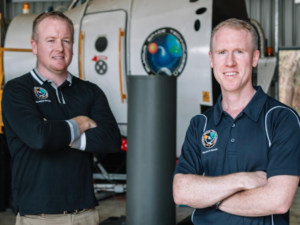Australian startup raises $14 million for smallsat launchers

WASHINGTON — Smallsat launch startup Gilmour Space has raised 19 million Australian dollars ($14 million) from investors.
The company’s namesake says he now has sufficient capital to see his Queensland, Australia-based venture through to a first launch of an orbital rocket in 2020, but acknowledges he’s still looking for a domestic launch site. Australia hasn’t hosted an orbital launch since 1971 when the U.K’s Black Arrow rocket lifted off from Woomera on its first and only successful satellite launch.
Gilmour Space is building Eris-100, a three-stage rocket for payloads up to 100 kilograms, and a larger variant called the Eris-400 that uses strap-on boosters to carry around 400 kilograms. Both rockets are focused on low Earth orbit. Eris-400 is slated to launch in 2021.
Gilmour Space has raised AU$26 million to date, founder and CEO Adam Gilmour told SpaceNews.
Australian venture capital firms Main Sequence Ventures and Blackbird Ventures led the AU$19 million Series B round announced Sept. 28, with participation from the U.S.-based firm 500 Startups and other unnamed investors. Blackbird Ventures also led Gilmour Space’s AU$5 million Series A round in May 2017.
Gilmour Space plans to use hydrogen peroxide and a “specially formulated mixture” of other fuels to power the rockets, Gilmour said. The three-year-old company will test the same engine in a sounding rocket called Ariel later this year.
Gilmour said the company is targeting $25,000 to $30,000 per kilogram for launch prices, which puts Eris-100 launches between $2.5 million and $3 million.
“Most of the customers we are talking to are still getting charged $50,000 to $60,000 a kilogram — or even more for a 3U [cubesat] — for anything up to say 50 kilograms, so we think we can be quite competitive,” he said.
The larger Eris-400 rocket is priced between $10 million and $15.2 million according to the Gilmour Space website.
Gilmour said the company will seek to keep costs down by limiting spending on staff and being prudent with research and development. Gilmour is 30 people today, he said, and will grow with its new capital to 45 to 50 people. The company’s G-70 engine took less than $5 million to develop, he said, including the cost of a flight test.
One of Gilmour’s investors, Blackbird co-founder Rick Baker, mentioned the company’s frugality as one of its strengths.
“This Queensland-based rocket company is well on its way to developing, building and launching a commercial orbital rocket for under AUD 30 million in capital raised,” he said in a statement. “The result will be a low-cost rocket that is going to change the economics of small launch.”
NASA’s former deputy administrator Dava Newman and former space shuttle commander Pamela Melroy joined Gilmour’s advisory board in July.
Australia’s new space agency also officially started operations in July with the goal to “transform and grow a globally respected Australian space industry.” Gilmour said Gilmour Space is working with the space agency on developing a mission that would “inspire the nation,” but that it is still in the planning stage.
Gilmour Space doesn’t have an official launch site yet, but Gilmour said the company is in discussions with the Queensland, Australia government about establishing a spaceport there.
“We think that’s the best place to have a launch site that gives you both polar and equatorial access,” he said. The company is also considering two other proposed spaceports, both in Australia, he said.
Gilmour said the use of hydrogen peroxide as fuel means the company can set up at a launch site quickly when one is ready.
“We have the infrastructure already. One of the good things about hydrogen peroxide is it is room-temperature storable, so we don’t need to take cryogenic tanks around with us if we want to do a mobile launch,” he said.
Gilmour said the company will seek to reach a launch cadence of a launch a month after two to three years of operations.
from SpaceNews.com https://ift.tt/2N5gmDX
Comments
Post a Comment